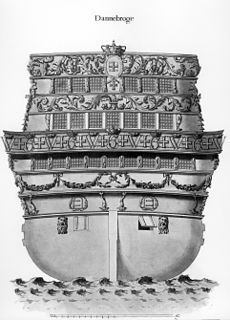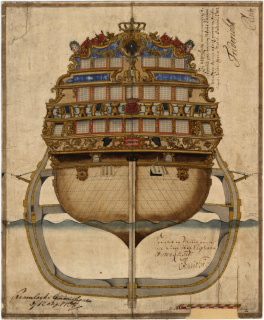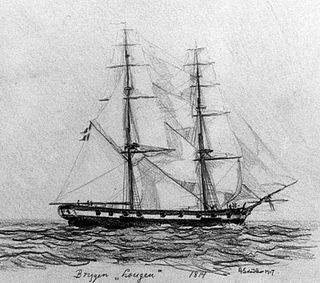 W
WHDMS Allart, a brig launched at Copenhagen in June 1807, was amongst the ships taken by the British after the second Battle of Copenhagen. In British service, she was recaptured by Danish-Norwegian gunboats after venturing too close inshore. Her subsequent service was in the Dano-Norwegian Navy's Norwegian Brig Division, which harried enemy frigates and convoys in Norwegian waters. On the separation of Denmark from Norway in 1814, Allart transferred to the Norwegian navy, who sold her in 1825.
 W
WAxel Thorsen (1810/1814–1863) was a Norske Kanonskonnert built in Trondheim, and launched on 28 April 1810. She was one of ten such ships built in either Bergen or Trondheim for the Danish-Norwegian navy before the end of the Napoleonic Wars when Norway became independent of Denmark at the Treaty of Kiel in 1814.
 W
WThe Dannebroge was a Dano-Norwegian ship-of-the-line that exploded and sunk October 4, 1710, during the Great Northern War. Almost all of its crew of 600 were killed, one thirds of the victims were Norwegians.
 W
WHDMS Elephanten was a ship of the line of the Royal Dano-Norwegian Navy that served from 1703 to 1728.
 W
WHDMS Friderichssteen or HMS Frederichsteen was a Danish Navy frigate, built in 1800, and captured by the Royal Navy in 1807 at the Battle of Copenhagen. She was taken into service as HMS Fredericksteen and served in the Mediterranean until being finally broken up in 1813.
 W
WGrinder was a gunboat serving as a tender, rather than a commissioned warship, to HMS Anholt, the British garrison on the island of Anholt during the Gunboat War. Grinder's origins are obscure, but the Danes captured her in 1810 and the British recaptured her in 1811. She was sold in 1832.
 W
WHDMS Grønland (Greenland) was a ship of the line of the Dano-Norwegian Navy, built in 1756 and decommissioned in 1791. Grønland spent considerable time in the Mediterranean Sea, where she protected Danish merchant convoys. Grønland took part in the bombardment of Algiers in 1770 but otherwise did not see any action in battle. It is noted in the Danish Admiralty's papers that she was an unusually seaworthy ship.
 W
WHolsteen was a 60-gun ship of the line in the Royal Dano-Norwegian Navy. She was commissioned in 1775 and the British Royal Navy captured her in the Battle at Copenhagen Roads on 2 April 1801. The British renamed the ship HMS Holstein, and later HMS Nassau. She participated in one major battle during the Gunboat War and was sold in 1814.
 W
WHDMS Kronprindsens Lystfregat was a yacht launched in Britain in 1785. George III gave it to his nephew Frederick, the Crown Prince of Denmark. Kronprindsens Lystfregat cost £10,347 to build and furnish.
 W
WLillebælt was a Danish 22-gun warship launched in 1801. The Danes surrendered her to the Royal Navy in 1807 and she became the 20-gun post ship HMS Little Belt. In a single-ship action in 1811 while the United States of America was at peace with Great Britain, USS President fired on Little Belt, ostensibly believing her to be HMS Guerriere, which had recently abducted a sailor from USS Spitfire. History is not sure who fired first, both sides claiming the other had fired initially. This action was the eponymous "Little Belt affair". British captain Arthur Batt Bingham maintained that the Americans fired first and that although his vessel had suffered heavy casualties he had not at any time surrendered. Little Belt was broken up in 1811.
 W
WHDMS Lougen was a brig of 18 guns, launched in 1791, and the name-vessel of her class of six brigs designed by the naval architect Ernst Stibolt. She was the first Danish warship to be copper-sheathed. She was active protecting Danish merchant shipping and suppressing pirates in the Mediterranean and in the Caribbean. In March 1801, she fought off the British privateer Experiment and the 22-gun warship HMS Arab in a single action. When the British captured the Danish West Indies in 1801, Lougen was part of the booty. The British later returned her to Denmark where she was broken up in 1802.
 W
WHDMS Lougen was a Danish naval brig launched in 1805. She saw service in the Danish navy and participated in two notable actions against the British Royal Navy during the Gunboat War. In 1814, as a result of the Treaty of Kiel, the Danes transferred her to the Norwegian navy. The Norwegians sold her to German merchants in the Scheld in 1825. She was finally shipwrecked near Bremerhaven in 1881.
 W
WHMS Manly was an Archer-class gun-brig launched in 1804. During her career first the Dutch captured her, then the British recaptured her, then the Danes captured her, and finally the British recaptured her again. The British renamed her HMS Bold after her recapture in 1813. She was sold out of service in 1814.
 W
WHDMS Najaden was a frigate of the Royal Dano-Norwegian Navy, which she served from 1796 until the British captured her in 1807. While in Dano-Norwegian service she participated in an action at Tripoli, North Africa. She served the Royal Navy as the fifth rate HMS Nyaden from 1808 until 1812 when she was broken up. During her brief British service she participated in some small attacks in the Barents Sea during the Anglo-Russian War.
 W
WThe Norwegian gun-ships were a class of ten armed schooners that served first in the Royal Dano-Norwegian Navy, and then after 1814 in the Royal Norwegian Navy. The first was launched in 1808 and the last was lost in 1872.
 W
WHDMS Prinds Christian Frederik was a ship of the line in the Royal Dano-Norwegian Navy. The ship was built at Orlogsværftet on the islet of Nyholm off Copenhagen and was launched in October 1804.
 W
WHDMS Printz Friderich was a ship-of-the-line launched in 1764, to a design by Frederik Michael Krabbe, a naval officer and leading ship designer of that period. Two other ships — Norske Løve and Øresund — were constructed to the same design. Little is known of her service history beyond that she received a new keel in 1775. She was lost in 1780. Her wreck was rediscovered in 2018.
 W
WHDMS Sarpen was a brig of the Royal Dano-Norwegian Navy, in which she served from 1791 until the British seized her in 1807. While in Dano-Norwegian service she participated in an indecisive action at Tripoli, North Africa. She served the Royal Navy as HMS Sarpen from 1808 until 1811 when she was broken up. During her brief British service she participated in the Walcheren Expedition. Her name is that of a waterfall on the Norwegian river Glomma.
 W
WHMS Seagull was the name vessel for the Seagull class of brig-sloops of the Royal Navy. She was launched on 1 July 1805 and saw active service under the British flag in Danish waters until 19 June 1808 when Dano-Norwegian forces sank her. The Danes raised her and refitted her for service in the Dano-Norwegian Navy, which she served until the end of the "English Wars" in 1814. She then was transferred to the Norwegians. She was finally decommissioned in 1817.
 W
WThe Sophia Amalia was a ship of the Royal Dano-Norwegian Navy named after Sophia Amalia, the wife of King Frederick III. The ship was built at Hovedøen in Christiania under the direction of English shipbuilder James Robbins and was launched in 1650. She was 51.8 meters long and at that time one of the largest naval vessels in the world. She was commissioned by King Christian IV specifically to surpass the British ship HMS Sovereign of the Seas. The ship was manned by a crew of 680 and had an armament of 108 guns, surpassing Sovereign of the Seas by eight guns.
 W
WStora Sofia was a Danish ship of the line that sank on 25 May 1645 near Buskär outside the harbour of Gothenburg.
 W
WHMS Turbulent was a Confounder-class 12-gun gun-brig in the Royal Navy. She was the first ship to bear this name. Built at Dartmouth, Devon by Tanner, she was launched on 17 July 1805. The Danes captured her in 1808. She was sold in 1814.